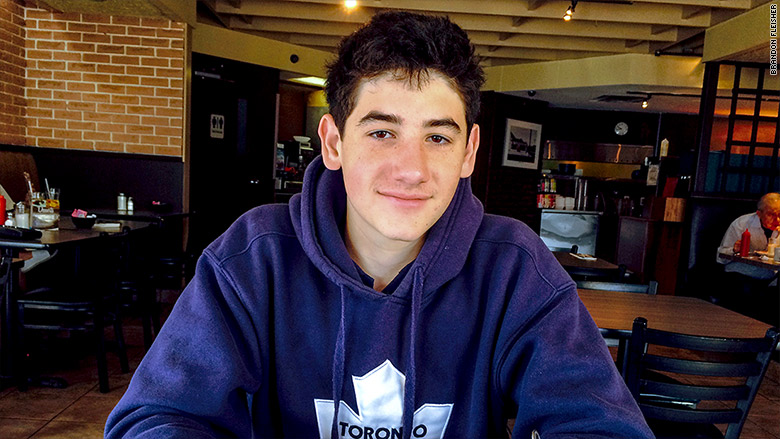
Talk about a tough year to invest.
Markets were volatile left and right, driven by three main reasons -- Oil prices tanked, China's economic slowdown got worse and the U.S. Federal Reserve kept everyone on their toes over whether it was going to increase interest rates for the first time in a decade.
Many investors were hit hard, especially newer ones. One problem among young investors was that their investments were not diversified enough, according to Openfolio, a platform that allows users to compare their stock portfolios and performance with each other.
About 57% of investors under age 25 only owned single stocks in their portfolio this year, Openfolio found. That means they were more vulnerable to a dramatic single stock decline without others to cushion the fall.
Young investors benefited, got burned and wized up a little. Here are 3 young investor tales -- and lessons learned -- from the market trail.
1. Don't get too emotional
Justin Brosseau got too emotional this year ... about at least one of his investments.
At 23, Brosseau is about to finish his most volatile year since he started picking stocks during his teenage years six years ago. He took steep losses from his investments in an oil ETF. He believed oil prices would bottom out at $36 a barrel and rise. Instead they recovered a little during the year and then again drifted down to under $35 a barrel, the lowest level since the financial crisis.
Why did Brosseau hold onto his oil investment while it tanked? Emotion, he says.
"You can really believe in a certain stock," says Brosseau, an IT consultant in Chicago, Ill. "But if you believe in it too much...your judgment is 100% clouded."
But Brosseau is finishing 2015 with a profit. It's a good thing that he was more diversified than some of his peers. Unlike traders his age, Brosseau owns 14 stocks.
His brokerage account in March had $12,300 and now he's at about $17,500.
His big buys this year were Disney (DIS), Apple (AAPL) and Netflix (NFLX). He jumped in and bought more of those companies' stock when the Dow plunged 1,000 points on August 24. He saw the market volatility as a buying opportunity.
But Brosseau also learned to be patient and invest for the long term. He was making 150 trades a month in May and June. ("I had some trades that I had for 30 seconds.") He has since calmed down.
"I learned that overtrading will constantly crush you," says Brosseau. "It was important for me to step back."
Brosseau is now on an investing hiatus: he hasn't sold or bought anything since August.

2. Stay away from controversial companies
Anderson Cooper's story on Lumber Liquidators (LL) laminate flooring with high levels of cancer-causing chemical formaldehyde sent the company's stock into a tailspin in March.
So Brandon Fleischer jumped in, thinking he was getting the stock at a bargain.
He blocked out the noise and looked at Lumber Liquidators' fundamentals -- same store sales, valuation -- and thought the company would bounce back. However, that hasn't happened yet. Lumber Liquidators is down 73% so far this year.
Fleischer still believes the company has strong business fundamentals, but he realizes he acted too impulsively.
Related: Why the bull market in stocks isn't dead yet
An 18-year old investor with a portfolio of three stocks worth about $144,000, Fleischer took a $30,000 loss on his stock in Lumber Liquidators.
"It taught me a big lesson -- don't invest in companies that have too much controversy around them," says Fleischer, a freshman at Ryerson College in Toronto.
Still, Fleischer's other big bets this year, penny stocks like Inuvo, a digital publishing company, paid off big time. Half his portfolio is in Inuvo (INUV) and its stock is up over 100% this year. Fleischer says his portfolio has doubled this year.

3. Don't panic when the market plunges. Buy.
Ryan Cutter invested thousands of dollars in Kinder Morgan, an energy infrastructure company. With oil prices tanking for much of the year, you can imagine how that went.
Cutter had $8,900 in Kinder Morgan (KMI) and lost about a third of his investment.
"I got burned pretty bad," says Cutter, 24, whose portfolio is currently worth about $50,000.
So Cutter, an MBA student a the University of Indiana, hit the books. He learned to look for the right stuff in a company's balance sheet. He pays more attention now to key yardsticks like price to earnings ratios. He says researching companies has been the key to success in the latter part of the year.
Like Brosseau, Cutter jumped in during the August 24th market plunge to buy more stock. He has since made big gains on his purchases in Chevron (CVX) and Disney (DIS). He's also shifted some of his portfolio overseas as U.S. stocks have struggled this year. Those wins have made up for his losses from Kinder Morgan.
Cutter's portfolio is ending the year slightly positive he says.
"It was the year that I learned the most," says Cutter. "Being in the green -- I consider that a moral victory."


